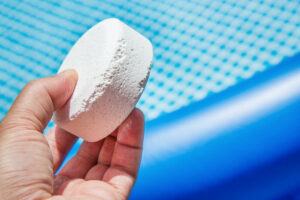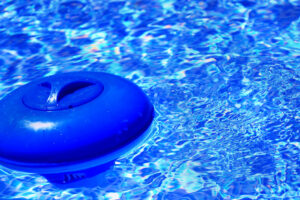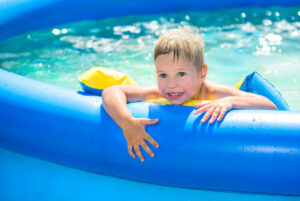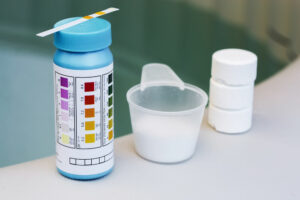As a pool owner, I often find myself wondering if I should add chlorine to my pool daily. Understanding the role of chlorine in pool maintenance and ensuring a clean and safe swimming environment is crucial. Let’s dive into the topic and explore the factors that determine the frequency of adding chlorine to a pool.
Chlorine plays a vital role in keeping a swimming pool clean and safe to use. It acts as a disinfectant, killing harmful bacteria and neutralizing other contaminants, such as algae, that can affect water quality. To maintain adequate chlorine levels, it is essential to know the different types of chlorine and their uses, as well as the necessary equipment for monitoring and maintaining these levels.

Decoding the frequency of adding chlorine to your pool involves considering multiple factors, such as pH levels and other external elements affecting chlorine levels. Pool cleaning and end-of-season maintenance also contribute to effective chlorine management, ensuring a clean and safe swimming environment throughout the year.
Key Takeaways
- Understanding the role of chlorine in pool maintenance is essential for a clean and safe swimming environment.
- Knowing the types of chlorine, their uses, and maintaining adequate levels can impact the frequency of chlorine addition.
- External factors, pH levels, and routine maintenance contribute to effective chlorine management.
Understanding Chlorine and Its Role in Pools
Chlorine plays a key role in maintaining the cleanliness and safety of pool water. It is a disinfectant that effectively kills potentially harmful bacteria and stops organic contaminants from thriving. I find it essential for every pool owner to understand how chlorine works, how often to add it, and what chlorine levels to maintain in the pool.
In its active form, chlorine turns into hypochlorous acid in water. Hypochlorous acid is a powerful sanitizer that targets and eliminates a wide range of bacteria, algae, and other organic materials. The primary reason I use chlorine in my pool is because of its unparalleled efficiency in destroying these contaminants.
Free available chlorine (FAC) refers to the amount of chlorine in the pool that is available to sanitize or disinfect the water. Accomplishing an appropriate balance of FAC is crucial to ensure effective pool water treatment; I personally aim to maintain a FAC level of 1.0 to 3.0 parts per million (ppm) in my pool. Having a suitable FAC level helps me provide a safe and enjoyable swimming environment for everyone.

Determining how often I should add chlorine to my pool relies on various factors, such as pool usage, sunlight exposure, water chemistry, and local climate. It is essential to test the pool water regularly to monitor the chlorine levels and adjust accordingly. In my experience, testing the water 2-3 times a week and adding chlorine daily or as needed works best for maintaining the desired FAC level.
In conclusion, understanding the role of chlorine and the factors influencing its effectiveness in my pool is crucial for maintaining a clean and safe swimming environment. By being knowledgeable about chlorine’s function and maintaining appropriate levels, I can ensure a pleasant and worry-free pool experience for all.
Essential Equipment for Maintaining Chlorine Levels
To maintain proper chlorine levels in my pool, I need to have the right equipment on hand. One essential tool is a reliable testing kit that measures chlorine concentration in parts per million (ppm). I prefer to use a kit that includes both a test strip and a liquid reagent. The test strip provides a quick reading, while the liquid reagent offers a more accurate measurement.
When using a testing kit, I make sure to test the water at least once a week. This allows me to adjust the chlorinator settings and ensure my pool stays within the ideal range of 1 to 3 ppm. I also take note of any significant changes in the chlorine levels, as this could signal a larger issue with the pool’s balance.
A chlorinator is another vital piece of equipment for maintaining chlorine levels in my swimming pool. This device automatically adds the correct amount of chlorine to the pool, eliminating the need for manual dosing. There are different types of chlorinators available, such as inline and offline systems. I typically choose one based on my pool size, preferences, and budget.
- Inline chlorinators connect directly to the pool’s plumbing system and release chlorine as the water passes through the device.
- Offline chlorinators work independently of the pool’s plumbing, drawing water from the pool, sanitizing it, and then returning it to the pool.
Finally, I invest in a high-quality pool cover to help maintain chlorine levels. A cover can prevent UV rays from breaking down the chlorine and reduces the amount of debris that enters the pool, which can affect chlorine levels.
Types of Chlorine and Their Uses

As a pool owner, I am often asked about the different types of chlorine available and their uses. In this section, I will be discussing the most commonly used forms of chlorine and how they can be beneficial to maintain a clean and healthy swimming pool.
The first type of chlorine that I use is chlorine tablets. These tablets are composed of trichlor, which is a stable and slow-dissolving form of concentrated chlorine. They are ideal for maintaining a consistent chlorine level in your pool. I usually place them in a floating dispenser or an automatic chlorinator, and they provide a steady release of chlorine, making them efficient for daily pool maintenance.
Another option I have encountered is liquid chlorine. It is a quick and easy way to add chlorine to your pool as it dissolves rapidly. Many pool owners prefer this form because it is typically less expensive than other types of chlorine and is known for its effectiveness in shocking a pool. I often use liquid chlorine when opening my pool for the season or addressing an algae outbreak.
There’s also the option of using chlorine granules. These are similar to tablets but are a faster-dissolving form of concentrated chlorine. They can be applied directly to the pool water or pre-dissolved in a bucket before being added to the pool. I find that they are perfect for a quick boost to the chlorine level during periods of high pool use or when my pool faces any contaminants.
For those who are looking for an alternative to traditional chlorine, you can consider saltwater systems. These systems generate chlorine from salt present in the pool water through a process called electrolysis. It offers the advantage of a more gentle and natural feeling to your pool water due to the lower chlorine concentration. I have friends who have converted to saltwater systems and have been very happy with the results.
In conclusion, the best type of chlorine for your pool depends on your specific requirements and preferences. When choosing a type of chlorine, consider the convenience, cost, and ease of application. Remember, it’s essential to maintain correct chlorine levels consistently to ensure that your pool remains clean and safe for use.
How to Add Chlorine to Your Pool

I always make sure to follow some basic steps while adding chlorine to my pool to maintain the water clean and safe for use. First, I test the pool water to determine the chlorine levels. Ideally, the chlorine levels should be between 1 and 3 parts per million (ppm). If the levels are too low, I proceed to add chlorine.
When it comes to adding chlorine, I use one of the three available forms: liquid, granular, or tablet. I prefer using liquid chlorine because it is easy to handle, and its effect is almost immediate.
To begin the process, I put on protective gloves and goggles for safety, as chlorine can be harsh on the skin and eyes. I carefully pour the required amount of liquid chlorine directly into the pool water, targeting the deeper end. I always add around 2 liters of liquid chlorine for every 10,000 liters of pool water. It’s essential to keep the pool circulation system running during the addition process to ensure proper mixing.
Granular chlorine is another option. If I decide to use this form, I first dissolve it in a bucket of water and then pour the solution into the pool, focusing on the deep end. For granular chlorine, I use around 60 grams of powder for every 10,000 liters of water.
Finally, there are chlorine tablets, which are convenient for slow-release chlorine applications. When using them, I place the tablets either in a floating dispenser or an in-line chlorinator. Typically, one tablet treats about 5,000 liters of pool water.
It is essential to add chlorine daily, especially in the summertime, as the sunlight reduces the chlorine’s effectiveness. I closely monitor the chlorine levels and adjust the amount accordingly. In the long run, this daily maintenance helps me keep my pool clean, clear, and safe for all to enjoy.
Decoding the Frequency of Adding Chlorine
Figuring out the correct frequency of adding chlorine to my pool is vital to ensure the water stays clean, sanitized, and safe for swimmers. There is no one-size-fits-all answer since the frequency is based on various factors. These factors include pool usage, weather conditions, chemical balance, and type of chlorine product I am using.
I need to test my pool’s chlorine levels regularly using a reliable pool testing kit. The ideal range for free chlorine in the pool is 1.0 to 3.0 parts per million (ppm). If the chlorine level falls below that range, I should add more chlorine to the pool. In general, I should test the pool chemical levels at least two or three times per week and make the necessary adjustments.
When it comes to chlorine products, there are different options available, including chlorine tablets, liquid chlorine, and granular chlorine. Each product has its specific instructions regarding dosage and frequency, which I must adhere to for optimal results. For example, some chlorine tablets slowly dissolve and release chlorine over an extended period, requiring less frequent application.
Another important factor to consider is the pool usage. If there is heavy usage, more chlorine will be consumed, requiring more frequent daily additions. On the other hand, if the pool is rarely used, a higher frequency may not be necessary, and fewer additions may suffice.
Weather conditions, especially rain, and sunlight, also impact chlorine levels. Heavy rainfall can dilute the pool water and lower chlorine levels, while constant exposure to sunlight can cause chlorine to break down faster. Therefore, I need to be more vigilant during the summer months and rainy seasons and check the chlorine levels more frequently.
Keeping the pool’s chemical balance in check is essential, as well. If the pH, alkalinity, or other parameters are off-balance, it can interfere with the effectiveness of chlorine, which may necessitate more frequent additions. Regular pH testing and adjustments will help ensure that chlorine works efficiently.
In conclusion, the frequency of adding chlorine to my pool is not a fixed daily ritual but depends on various factors. By testing my pool regularly, adhering to product guidelines, and taking into account pool usage and weather conditions, I can make informed decisions about when to add chlorine. Keeping a close watch on these factors will help me maintain a clean and safe pool environment.
Understanding pH Levels and Their Impact on Chlorine
As a pool owner, I’ve come to understand the importance of maintaining the pH levels in a swimming pool. pH levels play a crucial role in ensuring the effectiveness of chlorine and the overall health of the pool. In this section, I will discuss how pH levels affect chlorine’s efficiency and why it’s important to monitor them regularly.
The pH scale ranges from 0 to 14, with 7 being neutral. A pH level below 7 means the water is acidic, while a pH level above 7 indicates that the water is alkaline. The ideal pH level for a swimming pool lies between 7.2 and 7.6. At this pH range, the water is comfortable for swimmers, and chlorine is most effective in sanitizing the pool.
When the pH level is too high (above 7.6), chlorine becomes less effective at killing bacteria and algae. This means that even if you are adding chlorine daily, it may not be sufficient to keep your pool clean and safe. High pH levels also lead to scale formation and cloudy water.
On the other hand, when the pH level is too low (below 7.2), the chlorine becomes more aggressive and breaks down faster. Low pH levels can lead to corrosion of metal pool equipment, damage to the pool’s surface, and irritation for swimmers.
To maintain the optimal pH level, it’s important to test the water and adjust the alkalinity as needed regularly. Alkalinity serves as a pH buffer, helping to stabilize pH levels in the pool. When the alkalinity is within the ideal range (80-120 ppm), it becomes easier to manage pH levels, ensuring that chlorine remains effective in sanitizing the pool.
In conclusion, monitoring and maintaining pH levels are essential for the effectiveness of chlorine in a swimming pool. By keeping your pool’s pH within the recommended range and adjusting alkalinity as needed, you can ensure that your chlorine remains effective and create a safe and comfortable swimming environment.

Other Factors Affecting Chlorine Levels
Chlorine is essential for maintaining a clean and safe swimming pool, but there are several factors that can impact its levels. I will discuss some key factors that pool owners need to consider when it comes to chlorine levels.
Weather conditions play a significant role in determining how much chlorine is needed in the pool. Hot and sunny days can cause water to evaporate, leading to a higher concentration of chlorine in the remaining water. Additionally, bright sunlight can break down chlorine more quickly. UV rays from the sun interact with chlorine, causing it to dissipate faster, leading to the need for more frequent chlorine additions.
Bather load refers to the number of people using the pool. The more swimmers in a pool, the more contaminants are introduced into the water, such as perspiration, body oils, and cosmetics. These contaminants use up the available chlorine, requiring more frequent applications to maintain proper levels.
Pool usage is another factor that can impact chlorine levels. Pools with consistent, heavy use will require more frequent treatment. This is because higher amounts of organic matter, such as debris and algae, can grow in well-used pools, necessitating more chlorine to kill bacteria and maintain optimal water quality.
Heavy rain can also affect chlorine levels in a pool. Rainwater can dilute the pool’s chemical balance, reducing chlorine concentration. Additionally, heavy rain can introduce debris and contaminants into the pool, increasing chlorine demand. After heavy rainfall, it’s essential to test the chlorine levels and adjust accordingly to ensure the pool stays sanitized.
In conclusion, there are many factors that contribute to how frequently chlorine should be added to a pool. Taking these factors into account can help ensure that your pool remains clean and safe for swimming.
Importance of Pool Cleaning in Chlorine Maintenance

Maintaining a clean pool is essential for proper chlorine maintenance. As a pool owner, I know that regular pool maintenance helps to prevent algae growth and keep the water crystal clear. It’s necessary to remove dirt, leaves, and other debris from your backyard pool to keep it hygienic and visually appealing.
I always make sure to skim the water surface with a pool skimmer, as this helps remove floating debris like leaves and insects. A clean pool reduces the demand for chlorine since there are fewer contaminants for it to break down. That means I can save on chlorine costs by keeping my pool clean.
Untreated water can lead to the growth of algae, which is not only unpleasant to look at, but it can also create a slippery and dangerous surface in your pool. By regularly cleaning the pool and maintaining proper chlorine levels, I minimize the risk of algae and other unwanted organisms. Algae can also consume chlorine, so its presence makes it more challenging to maintain adequate chlorine levels.
I also make sure to check and clean my pool’s filtration system regularly to avoid clogs and ensure effective water circulation. A well-functioning filter keeps the water clean, reducing the amount of chlorine needed to combat contaminants. Here’s a list of routine maintenance tasks that I follow to keep my pool clean and maintain adequate chlorine levels:
- Skim the pool surface daily to remove leaves and debris
- Vacuum the pool floor at least once a week to remove dirt and sediment
- Brush the pool walls weekly to prevent algae growth and stains
- Check and clean the pool filter as recommended by the manufacturer
- Maintain proper water chemistry by testing and adjusting as needed
By following these steps, I ensure my pool stays clean and maintains the right amount of chlorine. This helps me create a safe and enjoyable swimming environment for my family and friends.
Pool Shocking: A Deep Dive
As a pool owner, I know it’s essential to maintain proper water chemistry and one of the key components of that is pool shock. Pool shock is a powerful oxidizer that eliminates organic contaminants and boosts the effectiveness of chlorine in the water. By performing regular pool shock treatments, I ensure that my pool stays clean, clear, and safe for swimming.
One of the first things I realized when using pool shock is that it’s important not to apply it directly in my pool; instead, I pre-dissolve it into a bucket of water. This prevents any damage to my pool’s liner and allows for more even distribution of the shock. Once the shock is fully dissolved, I slowly pour it around the edge of my pool, making sure the circulation system is running to help disperse the shock evenly.
As a pool owner, I pay attention to the different types of pool shocks available in the market. There are generally three types to choose from:
- Calcium Hypochlorite: A fast-acting pool shock that effectively kills bacteria and algae but can raise the pool’s calcium hardness level.
- Lithium Hypochlorite: A similar alternative to calcium hypochlorite, but with less impact on calcium hardness. It is ideal for pools with high levels of calcium hardness.
- Potassium Monopersulfate: A non-chlorine pool shock that oxidizes organic contaminants without affecting chlorine levels and does not raise the calcium hardness level.
To determine the appropriate dosage for my pool, I first need to consider the size of my pool and the type of shock being used. On average, a good rule of thumb is 1 pound of pool shock for every 10,000 gallons of water. However, it’s essential to consult the product label for specific dosage instructions.
When it comes to the frequency of pool shock treatments, the general recommendation is to shock the pool once a week. However, I adjust this schedule based on specific factors, such as the number of swimmers, weather conditions, or if the pool water appears hazy or has a strong chlorine smell.
In conclusion, pool shock is a crucial part of maintaining a clean and safe swimming environment. By understanding the types of pool shock and their appropriate usage, I can ensure that my pool stays clear and inviting all season long.
Maintaining A Safe and Clean Swimming Environment
One of the key aspects of owning a pool is ensuring a clean and clear swimming environment. To achieve this, I frequently test and adjust the water quality in my pool. Water quality is crucial because it maintains a stable and safe swimming environment for everyone who uses the pool.
In my experience, adding chlorine daily can be beneficial. The smell of chlorine, often associated with a clean pool, helps to ensure that bacteria and other contaminants are eradicated. By adding a small dose of chlorine to my pool each day, I can effectively manage the chlorine levels and prevent any imbalances that may occur.
To adjust the amount of chlorine added to the pool, I follow a few simple recommendations:
- Test the water daily: Using a reliable water testing kit, I check the water’s pH, alkalinity, and chlorine levels each day. This helps me determine if any adjustments are necessary.
- Follow the manufacturer’s instructions: When adding chlorine, I always adhere to the manufacturer’s guidelines regarding the recommended amount. This ensures that I avoid over-chlorination or under-chlorination.
- Consider the pool’s usage: If my pool experiences heavy usage, I may need to add chlorine more frequently. This is because swimmers can introduce a higher number of contaminants into the water, which can disrupt the chemical balance.
While adding chlorine daily might seem excessive, doing so allows me to have better control over the pool’s water quality, ultimately resulting in a safe and enjoyable swimming environment.
Cost-Effectiveness of Chlorine Pool Maintenance
As a pool owner, I understand that maintaining a swimming pool can be costly. However, chlorine is a cost-effective chemical that I use for maintaining my pool regularly. Daily chlorination can save me money in the long run by avoiding costly repair bills or long-term health issues associated with pool water.
I have found that the cost of chlorine highly depends on the type of chlorine product I choose to use. There are liquid, granular, and tablet chlorination options – each with its own price range. In my experience, liquid chlorine is the least expensive but might not be suitable for all pools due to its quick dissipation rate. Granular and tablet forms tend to be more expensive upfront but provide more lasting and controlled sanitization.

When I maintain my pool’s chlorine levels continuously, I ultimately use fewer pool chemicals overall. This is because a chlorinated pool prevents algae buildup, bacterial growth, and organic debris accumulation. These factors would otherwise necessitate the use of algaecides, shock treatments, and additional sanitizing agents, thus increasing my pool maintenance costs.
In my quest for cost-effectiveness, I have discovered energy-efficient pool equipment that helps me save on electricity bills. For instance, I use energy-efficient pumps and LED pool lights to reduce my monthly energy consumption while effectively circulating and sanitizing the water.
To summarize, adding chlorine daily to my pool is indeed cost-effective because it allows me to:
- Maintain a safe and clean pool environment with fewer chemicals
- Save money on potential pool repairs due to algae or bacteria damage
- Reduce the need for additional chemical treatments like algaecides or shock treatments
- Utilize energy-efficient equipment to save on electricity consumption
As a knowledgeable pool owner, I recognize the importance of daily chlorine maintenance for cost-effective pool care.
End-of-Season Pool Maintenance
As the swimming season comes to an end, it’s essential to take some steps to maintain my pool and keep the water healthy. One of the first tasks I do at the end of the season is to balance the water chemistry. This is important to maintain the pool surface and prevent algae growth.
I start by checking the total chlorine levels in the pool. For an optimal swimming environment, I aim to maintain the level between 1.0 and 3.0 ppm. To adjust the total chlorine, I carefully add the necessary amount of chlorine to the pool daily, based on my pool’s volume.
Next, I assess the free chlorine level to ensure that there’s a sufficient amount of active chlorine, which is crucial for preventing algae growth. I maintain the free chlorine level at a minimum of 0.5 ppm. This way, my pool stays sanitized without the excess risk of discomfort or irritation for future swimmers.
To preserve the pool surface and avoid potential damage, I pay attention to the water’s calcium hardness. I keep the calcium hardness level between 200 and 400 ppm. This balance helps prevent the water from becoming too corrosive or causing scale buildup on the pool’s surface.
At the beginning of the season, I perform a complete inspection of my pool to identify any potential problems, such as leaks, worn parts, or algae growth. This helps me stay ahead of any maintenance issues that may arise and ensures my pool stays in optimal condition all season long.
In conclusion, following these steps at the end of the season helps maintain the overall health and longevity of my pool while preventing problems such as algae growth, surface damage, and imbalanced water chemistry.
Conclusion
I find that daily chlorine addition is necessary to maintain a crystal-clear pool. Consistent chlorine levels help prevent algae growth and ensure the water is safe for swimming.
Keeping track of chlorine levels is easy with the help of testing strips or a digital testing kit. I recommend checking the levels daily and adjusting as needed to maintain the ideal range. This not only keeps the water clean but also makes pool maintenance a more manageable task.
In summary, adding chlorine to my pool daily has proven beneficial in my experience. It helps keep the water clean, safe, and enjoyable for myself and others to swim in. A regular routine of monitoring and adjusting chlorine levels is essential for maintaining a clean and healthy pool environment.
Frequently Asked Questions
How often should I chlorinate my pool?
I generally recommend chlorinating the pool at least once per day, ideally in the early morning or late evening. However, this can vary depending on factors such as pool usage, temperature, and external factors like rain or wind carrying debris into the pool.
What is the ideal chlorine level for swimming pools?
The ideal chlorine level for swimming pools is between 1 and 3 parts per million (ppm). Maintaining this range allows for effective sanitization while still being safe for swimmers. Be sure to test the chlorine levels regularly to ensure they remain within this range.
What is the best method for adding chlorine to my pool?
There are several methods to add chlorine to a pool, including using a floating chlorine dispenser, a chlorinator, or manually adding chlorine tablets or granules. Each method has its advantages and disadvantages. Personally, I prefer to use a chlorinator as it provides even and consistent chlorine distribution throughout the pool.
How much chlorine should be added at pool startup?
At pool startup, I recommend adding 2-3 ppm of chlorine. This helps to establish a proper chlorine residual and ensures the water is safe for swimming. Be sure to test the water after the chlorine has had a chance to circulate – this will help you determine whether more chlorine is needed.
What factors affect the rate at which pool chlorine dissipates?
Several factors can affect the rate at which pool chlorine dissipates, including sunlight, water temperature, and pool usage. Ultraviolet (UV) rays from the sun can break down chlorine, while higher water temperatures can cause chlorine to evaporate more quickly. Additionally, a higher number of swimmers can cause chlorine to dissipate at a faster rate due to the increased organic material in the water.
How long should I wait to swim after adding chlorine to my pool?
Generally, I recommend waiting at least 30 minutes to an hour after adding chlorine before swimming. This allows the chlorine to circulate and properly sanitize the pool water. Be sure to test the water before swimming to ensure the chlorine levels are within the safe range of 1-3 ppm.














